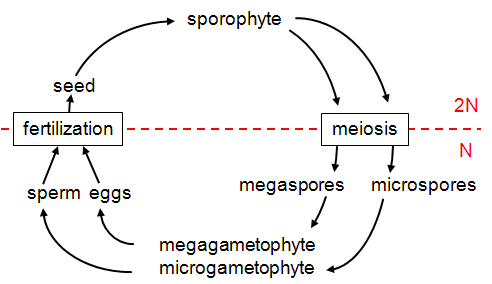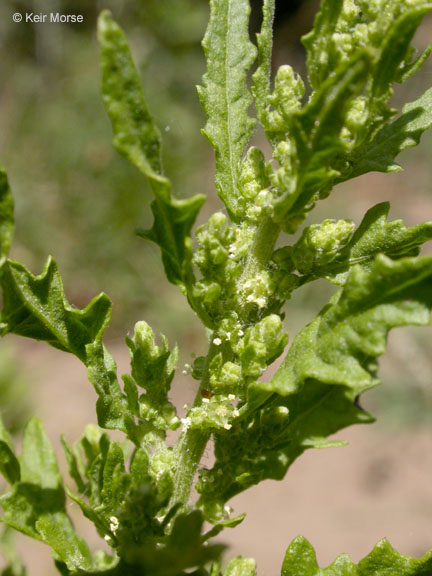Reproduction
Chenopodium ambrosioides is a
hermaphroditic plant, which means both the male and female
organs are contained on the same plant. A brief description of
the angiosperm (flowering plants) life cycle is described below.
The plant that can be seen with the naked eye that houses the flowers and produces reproductive tissues is a part of the
sporophyte generation. The sporophyte generation is diploid, referring to the
fact that it contains two sets of chromosomes. Meiosis occurs
in separate organs for the sperm and eggs within the same plant
(hence hermaphroditic). Meiosis is the process by which the eggs
and sperm are produced. The eggs are produced
in the stamen and the sperm is produced in the anther. Both the eggs and the sperm are considered
haploid which means they each only contain one set of
chromosomes. When the eggs and sperm fuse this is known as
fertilization and a seed forms. Once the seed grows into a plant
(sporophyte) the life cycle will continue to repeat itself if
conditions remain favorable.
flowers and produces reproductive tissues is a part of the
sporophyte generation. The sporophyte generation is diploid, referring to the
fact that it contains two sets of chromosomes. Meiosis occurs
in separate organs for the sperm and eggs within the same plant
(hence hermaphroditic). Meiosis is the process by which the eggs
and sperm are produced. The eggs are produced
in the stamen and the sperm is produced in the anther. Both the eggs and the sperm are considered
haploid which means they each only contain one set of
chromosomes. When the eggs and sperm fuse this is known as
fertilization and a seed forms. Once the seed grows into a plant
(sporophyte) the life cycle will continue to repeat itself if
conditions remain favorable.
 The neat thing about this plant in particular is the fact that
fertilization does not occur within the same plant. Although it is
possible for
fertilization to occur within the same plant because both the
eggs and sperm are produced in one plant, the pollen (the sperm) is
actually carried to another plant by the wind. This is referred to
as cross fertilization via wind dissemination. Interested in
learning about other plants that use the wind as a means of
fertilization? Check out
Cannabis sativa.
The neat thing about this plant in particular is the fact that
fertilization does not occur within the same plant. Although it is
possible for
fertilization to occur within the same plant because both the
eggs and sperm are produced in one plant, the pollen (the sperm) is
actually carried to another plant by the wind. This is referred to
as cross fertilization via wind dissemination. Interested in
learning about other plants that use the wind as a means of
fertilization? Check out
Cannabis sativa.
So why would cross fertilization be advantageous? As plants
themselves have evolved, from lacking true tissues (bryophytes) to
plants with seeds (gymnosperms) and flowers (angiosperms), so to
have the mechanisms of reproduction. One major factor for cross
fertilization is this process enhances the genetic diversity of the
plant, which allows for greater variation and greater oppurtunities
for the plant to tolerate and survive the ever changing environmental conditions
that plants are forever exposed to.
Next:
Interactions
Back to
Home